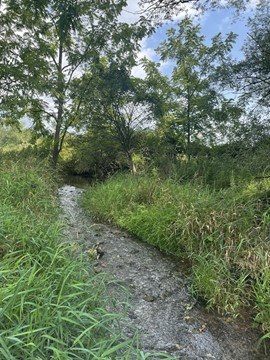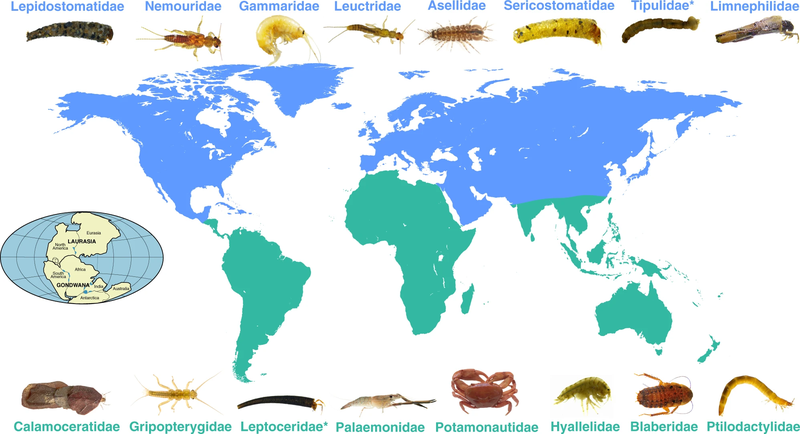Posted: September 21, 2021
Insect Biodiversity Center fellow and Ecology graduate student Francesca Ferguson highlights a recent study evaluating the role of aquatic insects as critical decomposers, globally, within stream ecosystems.

Photographed is Halfmoon Creek a 2nd order stream in Centre County. (Not included in the study – for size reference.)
Why does biodiversity really matter? How does biodiversity benefit an ecosystem? Is biodiversity as important as the abiotic controls, like temperature and precipitation, that regulate ecosystem functions? And can an ecosystem rely on only one keystone species to maintain its stability? These are questions that arose three decades ago bringing light to a debate in ecology and an ecological subfield called Biodiversity and Ecosystem Functioning (BEF) (1). These questions have inspired hundreds of studies to explore whether biodiversity serves as a critical mechanism for maintaining ecosystem function (such as biomass production, nutrient cycling, and decomposition).2 Over the years, the importance of biodiversity on nutrient cycling and biomass production has been proven, but when investigating decomposition, studies can yield contradictory and confusing results (2). To address this knowledge gap, a group of researchers from GLoBE (https://www.globenetwork.es/) conducted a holistic, worldwide study investigating instream detritivore influences on decomposition across 38, first to third order streams distributed across 23 countries (3).
Boyero et al. (2021) tested whether a higher diversity of stream detritivores, which are aquatic arthropods who primarily consume decaying organic matter, yield higher stream decomposition rates. They also examined how the abundance, biomass, and body size of detritivores can vary across sites at different latitudes. Aquatic systems play a significant role in decomposing exogenous litter material, making it an important system to investigate. Litter will fall into streams and deposit in depositional hotspots such as pools, where 80 – 90% of all in-stream decomposition takes place.
To investigate litter decomposition, they prepared six different assemblages of leaf litter mixtures and introduced them, in enclosed mesh bags, to five consecutive pools in each of the 38 streams for a total of 23-46 days. Upon retrieval, macroinvertebrates (such as aquatic insects) were collected from the bags to be counted, identified, and measured to calculate detritivore richness, diversity, and biomass. Detritivore-mediated decomposition was calculated as the difference in dried leaf litter mass between the coarse and fine-mesh litterbags.

Figure 5 from Boyero et al (2021): Different detritivore invertebrate communities were represented in northern versus southern hemispheres.
Researchers found that detritivore diversity and decomposition were positively correlated in the tropics and in temperate areas, with greater importance of diversity in the tropics and greater importance of detritivore abundance in the temperate regions. They also found that detritivore diversity and abundance varied with latitude, with higher values found in the northern hemisphere versus the southern hemisphere. This variation in invertebrate composition likely resulted from the geologic split of Pangea in the Late Jurassic (≈200 Ma ago), which makes the aquatic detritivore populations in the southern ecosystems sparser and more susceptible to species loss.
Dr. Bradley Cardinale, Department Head of Ecosystem Science and Management at Penn State University, and coordinator for the North American component of the research network and contributor to the midwestern temperate biome experiment, highlights during an interview that “We finally have confirmation that diversity makes a difference in decomposition, but what we don’t have is really good evidence on how this is going to affect people, water quality, and recreation”. Dr. Cardinale emphasized that these kinds of human-oriented questions are important future directions that ecologists should make.
This paper provided unequivocal evidence that biodiversity is critical to decomposition, agreeing with the hundreds of previous papers that illustrate how biodiversity really does matter for maintaining ecosystem function.
You read more about this study by reviewing this PSU news story or accessing the original article by clicking here.
References
(1) Plas, F. van der. Biodiversity and Ecosystem Functioning in Naturally Assembled Communities. Biological Reviews 2019, 94 (4), 1220–1245. https://doi.org/10.1111/brv.12499.
(2) Cardinale, B. Impacts of Biodiversity Loss. Science 2012, 336 (6081), 552–553. https://doi.org/10.1126/science.1222102.
(3) Boyero, L.; López-Rojo, N.; Tonin, A. M.; Pérez, J.; Correa-Araneda, F.; Pearson, R. G.; Bosch, J.; Albariño, R. J.; Anbalagan, S.; Barmuta, L. A.; Basaguren, A.; Burdon, F. J.; Caliman, A.; Callisto, M.; Calor, A. R.; Campbell, I. C.; Cardinale, B. J.; Jesús Casas, J.; Chará-Serna, A. M.; Chauvet, E.; Ciapała, S.; Colón-Gaud, C.; Cornejo, A.; Davis, A. M.; Degebrodt, M.; Dias, E. S.; Díaz, M. E.; Douglas, M. M.; Encalada, A. C.; Figueroa, R.; Flecker, A. S.; Fleituch, T.; García, E. A.; García, G.; García, P. E.; Gessner, M. O.; Gómez, J. E.; Gómez, S.; Gonçalves, J. F.; Graça, M. A. S.; Gwinn, D. C.; Hall, R. O.; Hamada, N.; Hui, C.; Imazawa, D.; Iwata, T.; Kariuki, S. K.; Landeira-Dabarca, A.; Laymon, K.; Leal, M.; Marchant, R.; Martins, R. T.; Masese, F. O.; Maul, M.; McKie, B. G.; Medeiros, A. O.; Erimba, C. M. M.; Middleton, J. A.; Monroy, S.; Muotka, T.; Negishi, J. N.; Ramírez, A.; Richardson, J. S.; Rincón, J.; Rubio-Ríos, J.; dos Santos, G. M.; Sarremejane, R.; Sheldon, F.; Sitati, A.; Tenkiano, N. S. D.; Tiegs, S. D.; Tolod, J. R.; Venarsky, M.; Watson, A.; Yule, C. M. Impacts of Detritivore Diversity Loss on Instream Decomposition Are Greatest in the Tropics. Nat Commun 2021, 12 (1), 3700. https://doi.org/10.1038/s41467-021-23930-2.

